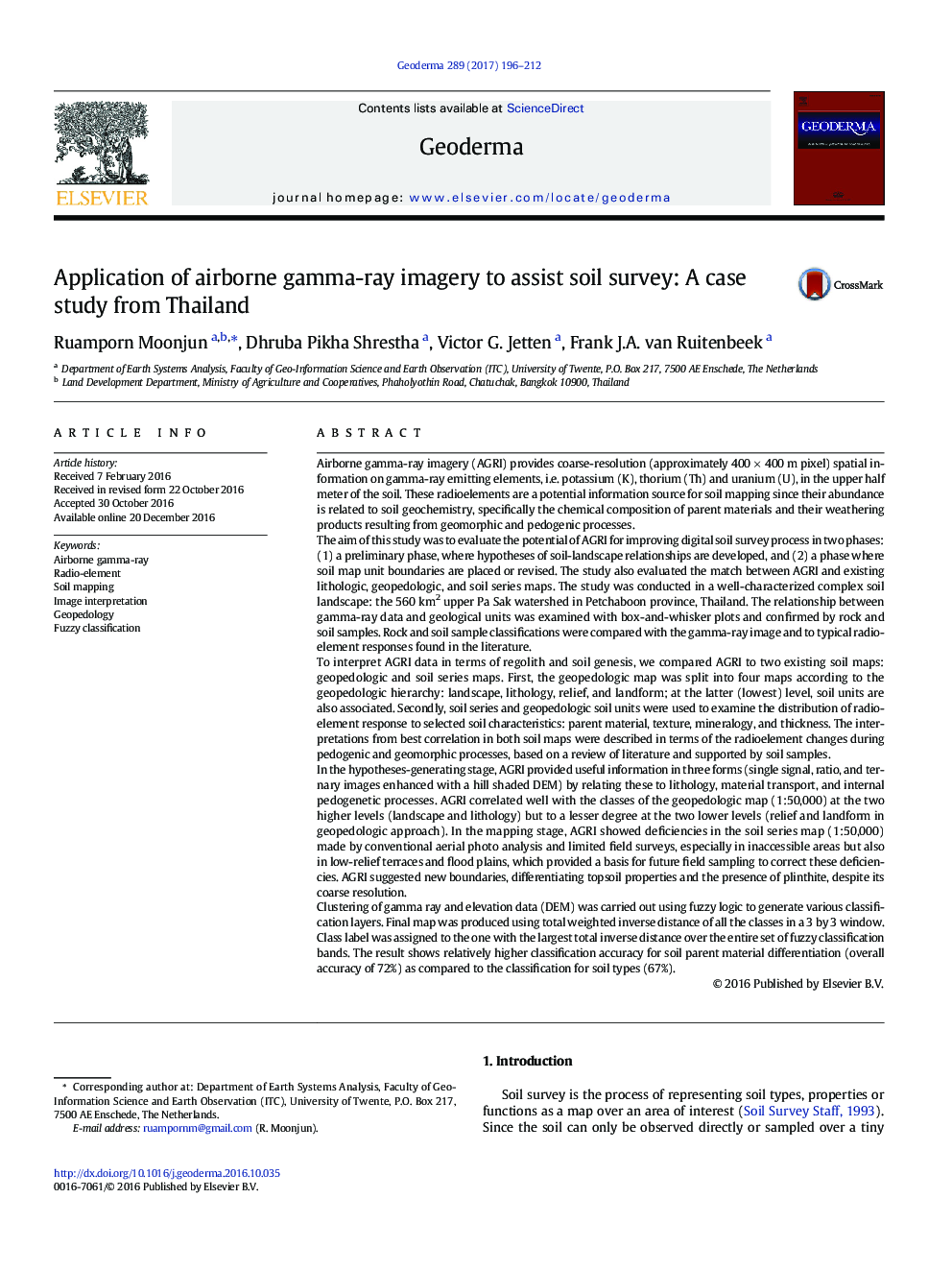| کد مقاله | کد نشریه | سال انتشار | مقاله انگلیسی | نسخه تمام متن |
|---|---|---|---|---|
| 5770728 | 1629428 | 2017 | 17 صفحه PDF | دانلود رایگان |
- Gamma-ray image provides potential information for soil survey in Thailand.
- Gamma-ray can investigate lithology, material transport and pedogenetic processes.
- Gamma-ray provides useful information in three forms as %K, eTh and eU.
- Gamma ray shows deficiency to soil in inaccessible mountainous and low relief areas.
- It'll be clustering of gamma-ray and DEM for soils and soil parent material mapping.
Airborne gamma-ray imagery (AGRI) provides coarse-resolution (approximately 400Â ÃÂ 400Â m pixel) spatial information on gamma-ray emitting elements, i.e. potassium (K), thorium (Th) and uranium (U), in the upper half meter of the soil. These radioelements are a potential information source for soil mapping since their abundance is related to soil geochemistry, specifically the chemical composition of parent materials and their weathering products resulting from geomorphic and pedogenic processes.The aim of this study was to evaluate the potential of AGRI for improving digital soil survey process in two phases: (1) a preliminary phase, where hypotheses of soil-landscape relationships are developed, and (2) a phase where soil map unit boundaries are placed or revised. The study also evaluated the match between AGRI and existing lithologic, geopedologic, and soil series maps. The study was conducted in a well-characterized complex soil landscape: the 560Â km2 upper Pa Sak watershed in Petchaboon province, Thailand. The relationship between gamma-ray data and geological units was examined with box-and-whisker plots and confirmed by rock and soil samples. Rock and soil sample classifications were compared with the gamma-ray image and to typical radioelement responses found in the literature.To interpret AGRI data in terms of regolith and soil genesis, we compared AGRI to two existing soil maps: geopedologic and soil series maps. First, the geopedologic map was split into four maps according to the geopedologic hierarchy: landscape, lithology, relief, and landform; at the latter (lowest) level, soil units are also associated. Secondly, soil series and geopedologic soil units were used to examine the distribution of radioelement response to selected soil characteristics: parent material, texture, mineralogy, and thickness. The interpretations from best correlation in both soil maps were described in terms of the radioelement changes during pedogenic and geomorphic processes, based on a review of literature and supported by soil samples.In the hypotheses-generating stage, AGRI provided useful information in three forms (single signal, ratio, and ternary images enhanced with a hill shaded DEM) by relating these to lithology, material transport, and internal pedogenetic processes. AGRI correlated well with the classes of the geopedologic map (1:50,000) at the two higher levels (landscape and lithology) but to a lesser degree at the two lower levels (relief and landform in geopedologic approach). In the mapping stage, AGRI showed deficiencies in the soil series map (1:50,000) made by conventional aerial photo analysis and limited field surveys, especially in inaccessible areas but also in low-relief terraces and flood plains, which provided a basis for future field sampling to correct these deficiencies. AGRI suggested new boundaries, differentiating topsoil properties and the presence of plinthite, despite its coarse resolution.Clustering of gamma ray and elevation data (DEM) was carried out using fuzzy logic to generate various classification layers. Final map was produced using total weighted inverse distance of all the classes in a 3 by 3 window. Class label was assigned to the one with the largest total inverse distance over the entire set of fuzzy classification bands. The result shows relatively higher classification accuracy for soil parent material differentiation (overall accuracy of 72%) as compared to the classification for soil types (67%).
Journal: Geoderma - Volume 289, 1 March 2017, Pages 196-212
